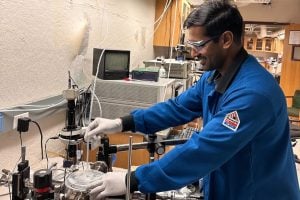
A team led by Johns Hopkins materials scientists has developed a new type of potentially wearable sensor using specially designed plastic-like materials that can detect acetone in human breath—a marker that could help diagnose diabetes—and identify other harmful chemicals in the air for environmental monitoring. Their research appears in the Journal of Materials Chemistry C.
“This technology could change the game in how we monitor our health and the environment,” said lead author Howard Katz, a professor of materials science and engineering at the Whiting School of Engineering. “Imagine having a small wearable device that could sniff out diabetes through your breath or alert you to dangerous air pollution in real time.”
Katz’s team set out to modify existing organic field-effect transistors or OFETs—electronic switches made from carbon-based materials that can change their electrical properties when exposed to chemicals—to elicit heightened electrical responses to volatile organic compounds in the air. VOCs are chemicals, such as formaldehyde, benzene, and acetone, that rapidly evaporate and become airborne, causing potential health issues.
“We wanted to create a semiconductor, which is a tiny switch that controls the flow of electricity in these devices, using a polymer we had experimented with before. We adjusted the polymer’s molecular composition by adding aniline, a substance commonly used in dyes, because we thought that it would detect gaseous acetone,” he said.
The researchers already knew that diketopyrrolopyrrole (DPP) polymers were good conductors of electricity and that aniline is reactive with acetone. They combined the two to attempt to make the device especially sensitive to acetone, making three polymers with varied concentrations of aniline.
“We chose to use different amounts of aniline to assess which would enable the device to work best,” says Katz. “We knew aniline could decrease the amount of current that could flow in a material, so the device would need more voltage to get more current. Too much voltage would make the semiconductor unstable and cause the OFET not to work.”
After aniline was attached to the polymers and placed in the device as semiconductors, the researchers conducted separate experiments with the three compounds by placing them in an airtight chamber. They then measured the current running through the device when the chamber contained only air before adding a very small amount of acetone, about 50 parts per million. “When the device was in the controlled environment with only air, the current running through it steadily increased. As soon as we added acetone, the current decreased – indicating that the transistors had recognized the presence of the gas and responded to it,” says Katz.
The team then inserted acetic acid, commonly known as vinegar, into the chamber, followed by dimethyl carbonate, a substance used in lithium-ion batteries. “These substances are molecularly similar to acetone, so we wanted to ensure that the device we made was especially sensitive to acetone and not just any gas,” says Katz.
After they found that the current continued to increase when the other gases were introduced, they tested the compounds as liquids in the chamber to see if the device’s response changed. “In this instance, we saw that the device was far more responsive to liquid acetone, an interesting finding which we hope to investigate further,” says Katz.
With their preliminary results, the researchers created more of the aniline-DPP polymer devices, adjusting the amount of aniline attached to the polymer, and repeated the experiments.
“We wanted to make the best combination to allow the most possible current to run through the device while maintaining its super-selectivity to detect gaseous acetone,” says Katz. “We made about half a dozen of these devices total, discarding one polymer from the first round of experiments because the combination of polymer and acetone prevented current from entering the device. We learned that we can’t add too much aniline because the device won’t work.”
Having fine-tuned their device to achieve maximum sensitivity to acetone, the team is now working to bring their technology to market.
“We are moving forward with scaling this material up and producing it, perhaps as a wearable device that could detect illness within the body,” says Katz.
The research team included Sasikumar Mayarambakam, a postdoc in materials science and engineering at the Whiting School; Riley Bond, ENGR’25 (PhD), Jimetochukwu Solomon, a researcher at Coppin State University’s Center for Organic Synthesis, and Hany F. Sobhi, professor of organic and clinical chemistry at Coppin State University.
This work was funded by the National Science Foundation, Partnerships for Innovation.